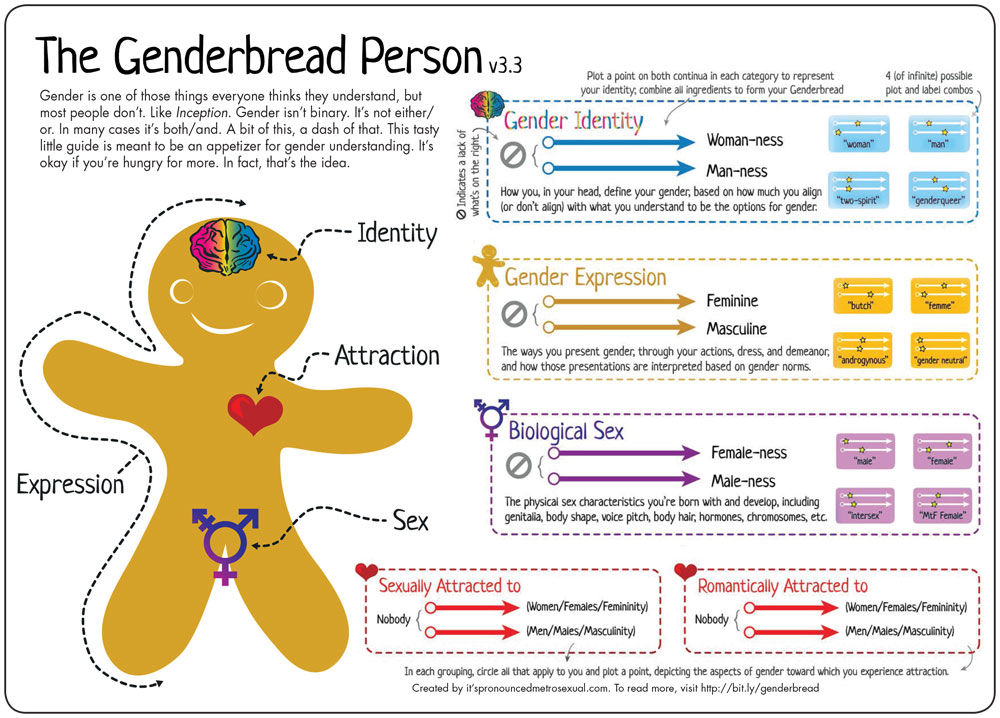What does gender mean to you?
Many people probably do not have have a good answer or may not know what gender really means. It is a slippery concept because it is not black or white and means something different to every person.
The diagram above breaks down the four parts that generally make up a person’s gender: gender identity, gender expression, biological sex, and sexuality. Each is a separate continuum where a person can fall at any point. Put all four together, and it’s one massive continuum.
A person who was born as a female and identifies as a woman and is attracted to men lives on the binary. A person who was born as a male and identifies as a man and is attracted to women also lives on the binary. All the people who do not fit into one of those two categories live on the non-binary.
1. Gender identity – How people think of themselves in terms of being a man, woman, or in between
Again, a person can fall at any point so someone can feel 100 percent man, or 100 percent woman, or 60 percent man and 40 percent woman, or anything else. It all depends on the individual. Sometimes how a person identifies themselves aligns with the sex assigned at birth, but not always.
cisgender– the prefix “cis” means “on the same side of.” Cisgender means how a person identifies him or herself matches the sex assigned at birth, or the sex and gender are on the same side. There are two options: 1) a person who is assigned male at birth and thinks of himself as a man and 2) a person assigned female at birth and thinks of herself as a woman.
transgender– the prefix “trans” means “on the other side of.” Transgender means how a person thinks of themselves does not align with the sex assigned at birth, or the sex and gender are on different sides. A person assigned male at birth may identify more as a woman just like a person assigned female at birth may identify more as a man. There is no data for the number of transgender people in the U.S.
A person can be transgender but not completely identify with the other gender. For example a person born as a male may know he doesn’t want to be a male, but also not totally be a woman and be somewhere in between.
gender queer or gender fluid– a person doesn’t really feel like a man or a woman, or their gender is fluid and they can switch from feeling like a man to feeling like a woman. This person may choose to use the neutral pronouns “they/them/theirs.”
2. Biologic sex – Male, female, or intersex
A person’s sex is determined by physical traits—chromosomes, hormones, body shape and hair, gonads, internal organs and genitalia. It is assigned at birth and is either male or female, unless a baby has a disorder of sex development, sometimes called intersex, when something unusual occurs during the sex development phase in the fetus. These babies can have missing or extra sex chromosomes, hormone abnormalities and ambiguous genitalia. Children with disorder of sex development may use hormone blockers to delay puberty to have more time to decide what gender they identify with and want to present as. Again, they can also identify somewhere in between. Children with DSD work with pediatric endocrinologists to transition to the gender they decide.
3. Gender expression – How people choose to show their femininity or masculinity, whether it’s with clothes, voice, interests, whatever
Gender expression is partly natural and partly learned because people observe and mimic ways other people show that gender. For example, women (more than men) tend to wear make up so a person who identifies as a woman may express that through make up. Gender expression can change from place to place based on what is normal for a gender within that population.
A cisgender person who has some characteristics of the opposite gender does not mean that person is transgender. For example, a boy who plays with dolls does not mean he is transgender or gay. It means he likes to play with dolls. Just like a man with a feminine tone of speech should not be assumed gay.
4. Sexuality – Who a person is attracted to
The prefix “hetero” means “pertaining to the opposite sex” so heterosexual people, or straight people, are attracted to the opposite sex, like a man who is interested in a woman.
The prefix “homo” means “pertaining to the same sex” so homosexual people, or gay people, are attracted to the same sex, like a man who is interested in another man.
Bisexual means attracted to both sexes
Pansexual is attracted to everyone
Asexual is attracted to no one
Summary
Making the distinctions between gender identity, biological sex, gender expression, and sexuality can be puzzling, even for the most curious and sympathetic bystander. If you are unsure of your gender identity or sexuality, that is OK. Some people take their whole lives to figure that out. If you meet someone and are unsure of their gender identity or sexuality, the best method is to treat them like any other person you meet and be kind and curious. Many people within the non-binary gender community prefer that people ask for their preferred pronouns, or how to refer to them.
After understanding the four main parts of gender, now use the diagram above to plot the point you fall on each continuum.





0 Comments